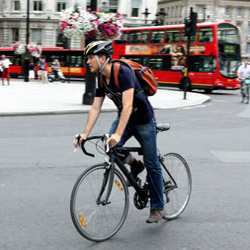
There are some patterns to the total reduction such as fewer people in rural areas and fewer older people cycling. And there are important relations to the level of job, with lower skilled work often associated with cycling. So changes to the general economy may be implicated as higher incomes result in higher car usage, but higher skilled work involving longer distances travelled.
In all of this there are limits to what we should infer because of who is counted. Only those in employment are considered, so full time students will not have their travel to college or university recorded, making the high levels observed in Cambridge (29%) more remarkable, and giving an insight into the contrast with Oxford (17%). The high level of unemployment among the young may also distort the picture of the jobs done and how people travelled to work.
The census records the postcode for place of work, so distance is also considered, which shows the increases over time we might expect for distances less than 2km. We also see more reassuring absolute levels of 5% of people outside London cycling to work if the distance is less than 5km. The striking pattern is the drop in those travelling less than 2km by bicycle, presumably the diminishing older group, and a shift away from utility cycling to commuting.
These distance data present a number of frustrations in mapping direct distances from usual residence to place of work. This neglects the need to follow some sort of road, but also results in those with second homes anomalously cycling more than 60km (each way) on their way to work. Another issue is that the data are for the longest distance mode if using several forms of transport, and for the home local authority not the destination, so that data reflect journey start points not end points (i.e. attitudes to transport rather than rush hour traffic patterns).
{mbox:lightbox/cycling-walking-london.png|width=300|height=240|caption=Click to enlarge|title=Proportions of workers either walking or cycling to work comparison of men and women}
The most interesting analysis comes in the comparison of male and female cycling proportions in local authorities (see the graph on the right). Plotting the two against each other sees a consistent pattern emerge of a greater proportion of men using a bicycle to complete the majority of their journey than women. However, when both walking and cycling are included together (so called active travel) the pattern is reversed. As with observational data in general, the more detail considered, the complex a picture emerges.
Attempts to understand the effect of cycle hire schemes will be frustrated by the decennial nature of the data. And they must also deal with a snapshot at the end of March, which may be more seasonal than is useful to understand the longer term health benefits. And according to simulations these benefits may be substantial for older adults, particularly men.
Those wishing to divine a Bradley Wiggins effect on cycle commuting are thwarted as even though he won the Tour de France in 2012, these data are from March 2011. Similarly, although for most statistics comparable data are available for Scotland, no analysis has been published from their census at this stage. And if you want to make a multivariate analysis of the suggestive factors which seem to relate to cycling, those are not available, and when they are it will be at most a 10% sample, losing the detail of fairly rare activity in some areas.
While without the census data like this might not be available in this sort of detail at all, they are clearly rather limited, most particularly in their timeliness. In a fast developing phenomenon which has been subject to substantial investment and political activity, waiting until the next census for good data will be frustrating. However, it may be that the e-census can use more structure to ask, for example, full time students how they travel to their place of study.




